#Nitidulidae
Text


Bug of the Day
Found this cool sap beetle feeding on moth bait last summer.
(Glischrochilus sanguinolentus)
#Glischrochilus sanguinolentus#Glischrochilus#Nitidulidae#sap beetle#beetle#Coleoptera#insect#BotD#bug of the day
130 notes
·
View notes
Text

oh my god everyone Please look at this sap beetle with little red hearts on its back <3
#i love him i pinned him from my lab instructors samples :)#entomology#insect#insect tw#bug#bugs#Nitidulidae
16 notes
·
View notes
Photo

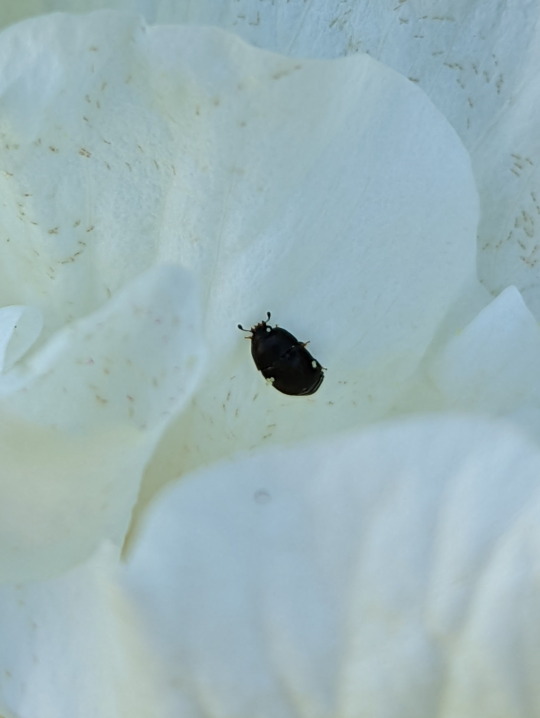
Small Sap-feeding Beetles inside a Hibiscus flower.
Unknown, Nitidulidae
Foodplant: Hibiscus tiliaceus
30/05/22
#Hibiscus#Nitidulidae#unknown#Sap-feeding Beetles#Coleoptera#Cucujoidea#Cucujiformia#Polyphaga#beetles#bugs#bugs tw#bugblr#insects tw#insectblr#entomology#insecta#Arthropods#Arthropoda
7 notes
·
View notes
Text
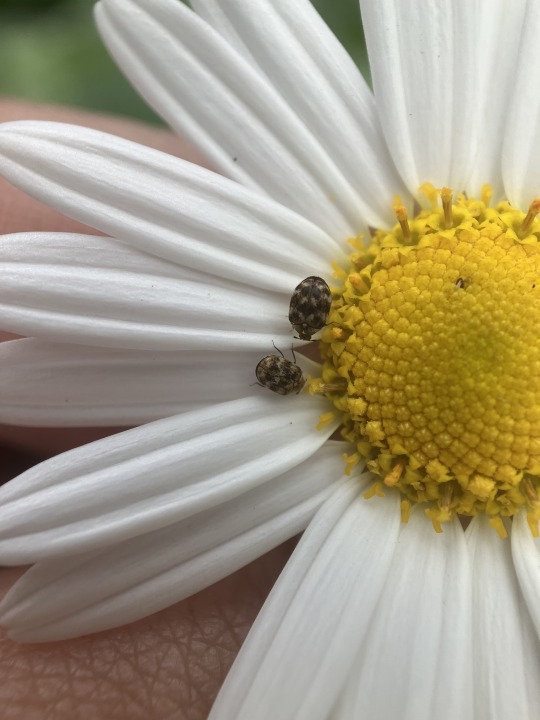



beetles i’ve seen recently 🪲💛
#for rose bc i can finally upload these pictures#rosacoleoptera#i like we both have bug urls 💛#insects#beetles#Coleoptera#anthrenus#I don’t know the little guy I think it’s a nitidulidae#Ok I don’t know the scarab either#Last one I think is an adelium#Wow. Just realising I’m not that good at beetle id 💛💛💛 except for dermestids lmao#I’m gonna curate some neuroptera soon so maybe I’ll take microscope photos
8 notes
·
View notes
Photo
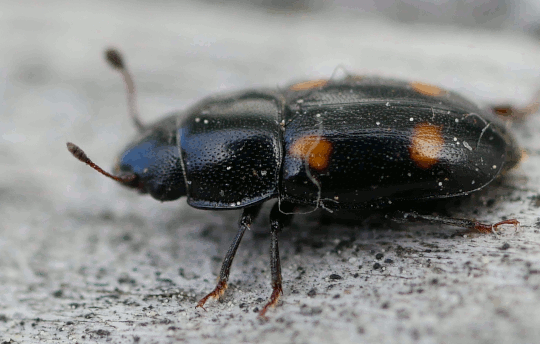
84 notes
·
View notes
Photo

No spectacular photography here, but I'm gonna get up on my soapbox for a second. A lot of sightseers consider Winter to be somewhat devoid of interesting wildlife. Not so! These, along with two other species, are the fruits of just a 15 minute walk between classes. Spring and summer will always be peak seasons, but there are still bugs to be found, even in the snow! (still haven't found a snow scorpionfly though) - - - #bug #insect #insects #bugs #insectphotography #macro #macrophotography #beetle #coleoptera #nitidulidae #sapfeedingbeetle #arachnid #arachnida #spider #fly #diptera #brachycera #hemiptera #hopper #cicadomorpha #nature #snow #winter #ice #wildlife
#bugs#coleoptera#bug#arachnid#winter#spider#sapfeedingbeetle#cicadomorpha#macrophotography#arachnida#beetle#nature#ice#hopper#macro#diptera#insectphotography#nitidulidae#wildlife#fly#insects#insect#brachycera#hemiptera#snow
31 notes
·
View notes
Photo

Four-spotted Sap Beetle (Glischrochilus quadrisignatus) in our backyard, May 2018. As implied by the name, these beetles are attracted to and feed upon sap, but they also feed on rotting fruit and nectar in flowers. They are also occasionally predators of smaller insects. . . . . . . . #nature #ontario #sapbeetle #nitidulidae #glischrochilus #glischrochilusquadrisignatus #beetle #beetlesofinstagram #beetles #backyardwildlife #gardeninsects #backyardbugs #macrophotography #invert_macro #coleoptera #insects_of_our_world #norfolkcounty #norfolkwild #blognorfolk #simcoeontario (at Simcoe, Ontario) https://www.instagram.com/p/B_r-WdcgfIP/?igshid=15gcuvgg714uy
#nature#ontario#sapbeetle#nitidulidae#glischrochilus#glischrochilusquadrisignatus#beetle#beetlesofinstagram#beetles#backyardwildlife#gardeninsects#backyardbugs#macrophotography#invert_macro#coleoptera#insects_of_our_world#norfolkcounty#norfolkwild#blognorfolk#simcoeontario
0 notes
Text
Fwd: Graduate position: UBern.BeetleMatingEvolution
Begin forwarded message: > From: [email protected] > Subject: Graduate position: UBern.BeetleMatingEvolution > Date: 22 October 2021 at 08:36:25 BST > To: [email protected] > > > > PhD in evolutionary ecology at University of Bern > > “Evolution of mating and reproduction in an invasive beetle pest” > > Application deadline: > 15 November 2021 > > A fully funded 4-year PhD position is available at the University > of Bern, Institute of Bee Health, starting on 01.01.2022 (a > later start is negotiable). The salary is according to the SNF, > including social security contributions from the Kanton of Bern > (https://ift.tt/2HL1XOE). > > The project: > > Biological invasions are major drivers of global change and can impact > ecosystem functioning as well as human food security. The occurrence of > such invasions is likely to increase drastically, thereby creating an > urgent demand to better understand underlying evolutionary aspects, such > as how biological mechanisms may contribute to the success and impact of > an invasion. Despite major advances in the field, mechanisms for initial > invasion success and optimal strategies to foster invasion impact are > still debated. In particular, surprisingly little attention has been > paid to the roles of mating systems and reproduction in insects, even > though they are among the worst invaders globally both in ecologically > and economically terms. > > We seek a highly motivated PhD student to investigate evolution of > mating and reproduction in an invasive beetle, the small hive beetle, > Aethina tumida Murray (Coleoptera: Nitidulidae), which is a nest parasite > of bees endemic to sub-Saharan Africa. Different selection scenarios > will be considered in the endemic range, during transport, and after > establishment in its novel ranges. Behavioural, genetic, morphological > and physiological data for phenotypic traits will be combined across > multiple endemic and invasive populations. The PhD student will be based > and conduct DNA work in Switzerland and will also work in the field at > least at three locations (Australia, Brazil, Italy, Kenya, South Africa > or USA). The research work also includes statistical data analysis and > publication of results in international peer-reviewed journals (N=3 > papers minimum). We offer membership in an ambitious global research > team and state-of-the-art facilities. > > Requirements: > > MSc in Biology or related subjectKnowledge of and keen interest in > insect evolution, mating and reproductionWillingness to work under > potentially uncomfortable field conditions abroadExperience with > statistical analysisKnowledge and experience in molecular biologyGood > self-organization, communicative personality and team-orientedExperience > in speaking and writing in English > > For queries concerning the application process and for project-related > questions, please contact Dr.AnnaPapach ([email protected]). > > Selected candidates will be invited to an online interview. > All applications should include: > > Cover letter in English describing your motivation, research interests > and relevant experience (up to two pages); Curriculum vitae including > names and contact details of at least two scientific references; Digital > copies of MSc/BSc/Diploma certificates and transcript of records. > > Please send all documents as a single PDF to Prof.Dr.PeterNeumann > ([email protected]). > > Anna > > > "[email protected]" >
via IFTTT
0 notes
Photo
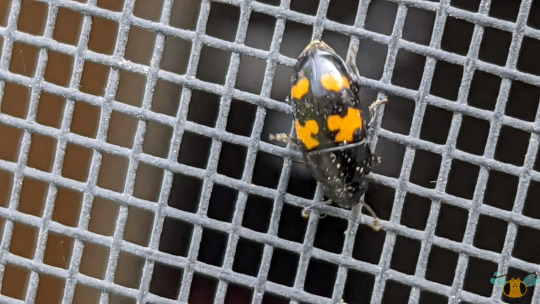
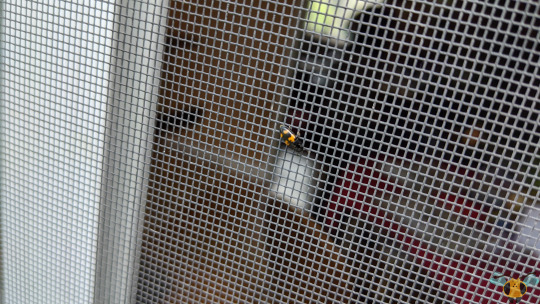


Picnic Beetle - Glischrochilus fasciatus
Finding such a tiny Beetle on the screen door presented a good opportunity to try out the zoom ability of the Pixel 4′s to see the image clarity. While the zoom is very good, the images remaining mostly crisp, the focus of the camera is the limiting step when using a phone. Still, don’t let that discourage you fellow bug hunters! Always do your best when trying for images of the beautiful insects the world has to offer! I’ll certainly aim to improve my own shots. Especially if it rewards with wonderful new species for the blog like this Picnic Beetle. It has such a wonderful name too: Picnic Beetle. Sounds like something you’d be pleased to find while enjoying lunch around on the grass. This isn’t an apt realization however, as this Beetle is somewhat of a pest, drawn to scent of good food, fruits in particular. I’d still rather have them join my picnics over a handful of Yellowjackets; Beetles of this size are more likely to be adorable than aggressive.
Though they look very different from each other, the Brown Yucca Beetle and this Beetle belong to the same family - Nitidulidae, or Sap Beetles. The latter has some familiar behavior to the former, being drawn to feed on sap from plants. While the Yucca Beetles has its specialization, the Picnic Beetle appears to be more of a generalist, taking sap from wherever it can, along with juices of decaying fruit. They seem to have a preference for raspberries, which might be a problem of us given the bushes in the backyard. I’ll have to keep an eye on them, lest grubs emerge from the fruits! Finally, while this Beetle looks very distinct at first glance, it has a few Beetles that look similar to it, so great attention to detail will be need to properly identify it, including checking the underside. While i didn’t check it intentionally (I saw the Beetle crawling on the screen from the inside of the house), this Beetle had a dark underside, confirming its identity. Other species of Glischrochilus Beetles may have different colors on their underside, so its better to check. You might also get lucky and find a few mites on the underside too (I noticed a few, not pictured) hitching a ride to a food source. For a view of this form of teamwork, refer to the posts featuring Clown Beetles.
*Note: The wrong day was queued (before the description was added no less) and this Beetle debuted a bit early on the blog. How embarrassing! All fixed now.
Pictures were taken on May 22, 2020 with a Google Pixel 4.
#jonny’s insect catalogue#insect#beetle#picnic beetle#coleoptera#sap beetle#toronto#may2020#2020#ontario insect#entomology#nature#invertebrates
0 notes
Photo



Bug of the Day
Well, my new homemade moth bait holders haven’t attracted any moths so far, but they did attract a huge batch of picnic beetles (Glischrochilus fasciatus) that appear to be living in the plastic scrubby part :-S. Apparently they have their own phoretic mites, too...
124 notes
·
View notes
Text
Bierkevertje
We noemen het ‘t bierkevertje, verschijnt in deze tijd ikbuiten een biertje drink.
Het is de Glischrochilus quadrisignatus. Een glanskever ca. 3 mm.

Een uitgebreide familie met diverse geslachten vormen de glanskevers (Nitidulidae). Ze worden ook wel bloemenkevers genoemd. Dit is de Glischrochilus quadrisignatus


View On WordPress
0 notes
Text
11 Loài Bọ Cánh Cứng Ăn Xác Người
Bọ cánh cứng ăn xác người và những đóng góp cho ngành y học
Trong những trường hợp tử vong khó xác định nguyên nhân cái chết, các nhà côn trùng học pháp y sử dụng côn trùng như một công cụng hữu ích để giúp các nhà điều tra xác định điều gì đã xảy ra với nạn nhân.
Bọ cánh cứng ăn xác người cung cấp một dịch vụ sinh thái quan trọng bằng cách tiêu thụ các sinh vật đã chết. Những con bọ cánh cứng khác thì tiêu thụ xác người.
Các nhà côn trùng học đã thu thập bọ cánh cứng và một số côn trùng khác trong xác người. Họ quan sát vòng đời và những hành vi của bọ cánh cứng để xác định thời gian tử vong của thi thể.
11 Loài Bọ Cánh Cứng Ăn Xác Người:
Danh sách dưới đây bao gồm những loài bọ cách cứng ăn xác người hoặc có liên quan đến xác người. Xếp giảm dần theo mức độ phổ biến và những đóng góp cho ngành y học.
01of 11Dermestid Beetles (họ Dermestidae)
Dermestids còn được gọi là bọ cánh cứng da. Ấu trùng của chúng có khả năng tiêu hóa keratin (một thành phần trong da người) một cách khác thường. Bọ cánh cứng Dermestid đến vào thời điểm cuối của quá trình phân hủy, sau khi các sinh vật khác đã nuốt các mô mềm trong xác người và tất cả những gì còn lại là da khô và tóc.
Ấu trùng Dermestid là một trong những loài côn trùng phổ biến nhất mà các nhà côn trùng học pháp y thu thập được từ xác chết của con người.
02of 11Bone Beetles (họ Cleridae)
Bọ cánh cứng họ Cleridae còn được biết đến với cái tên phổ biến khác là bọ cánh cứng rải rác. Hầu hết chúng đều thích ăn ấu trùng của các loài côn trùng khác. Tuy nhiên, một nhóm nhỏ lại thích ăn thịt tươi.
Khi nhắc đến các loài bọ cánh cứng thuộc họ Clerids, các nhà côn trùng học thường đề cập đến bone beetles và ham beetles. Tuy nhiên có một loài phổ biến hơn, dó là Necrobia rufipes hoặc bọ cánh cứng chân đỏ. Bone Beetles đôi khi được tìm thấy trong xác chết, giai đoạn cuối của sự phân hủy.
03of 11Carrion Beetles (họ Silphidae)
Ấu trùng bọ cánh cứng Carrion ăn thịt động vật có xương sống. Con trưởng thành thì ăn sâu non, bọ cánh cứng Carrion giúp chúng ta kiểm soát sâu hại trong vườn.
Một số thành viên trong họ Silphidae được gọi là bọ cánh cứng chôn vì chúng có khả năng chôn sống những xác chết nhỏ. Thật dễ dàng để tìm thấy bọ cánh cứng nếu bạn không phải là người điều tra tử thi. Bọ cánh cứng Carrion định cư trong một xác chết trong bất kỳ giai đoạn phân hủy nào.
04of 11Hide Beetles (họ Trogidae)
Bọ cánh cứng ngụy trang thuộc họ Trogidae có thể dễ dàng bị bỏ qua, ngay cả khi chúng đã định cư vào một xác chết người hoặc xác chết động vật. Những bọ cánh cứng nhỏ này có màu sẫm và có kết cấu thô, nhờ đó chúng ngụy trang trong xác chết thối rữa hoạt bùn mà khó bị phát hiện. Mặc dù chỉ có 50 loài được tìm thấy ở Bắc Mỹ nhưng các nhà côn trùng học pháp y đã thu thập được tới 8 loài khác nhau trong một tử thi.
05of 11Scarab Beetles (họ Scarabaeidae)
Họ Scarabaeidae là một trong những họ bọ cánh cứng lớn mạnh nhất, với hơn 19.000 loài trên toàn thế giới và khoảng 1.400 ở Bắc Mỹ. Nhóm này bao gồm các con bọ cánh cứng phân (dung beetles), còn được gọi là tumblebugs, có thể được tìm thấy trên (hoặc dưới) xác chết. Chỉ một số ít loài (14 hoặc hơn) đã được thu thập được trong xác người ở Hoa Kỳ.
06of 11Rove Beetles (họ Staphylinidae)
Rove Beetles có liên quan đến xác động vật và xác người, mặc dù chúng không phải là loài bọ cánh cứng ăn xác người. Chúng ăn dòi và ấu trùng côn trùng khác tìm thấy trong xác chết.
Bọ cánh cứng Rove định cư trong một xác chết vào bất kỳ giai đoạn phân hủy nào. Staphylinidae là một trong những họ bọ cánh cứng lớn nhất ở Bắc Mỹ, với hơn 4.000 loài thành viên
07of 11Sap Beetles (họ Nitidulidae)
Hầu hết bọ cánh cứng sáp sống gần chỗ nước lên men, vì vậy bạn có thể tìm thấy chúng trên những quả dưa hấu hoặc những cây bị chảy sáp. Một số loài bọ cánh cứng sáp thích xác chết, và những loài này có giá trị trong việc phân tích pháp y.
08of 11Clown Beetles (họ Histeridae)
Clown Beetles sống trong tử thi, phân, và những vật thể đang trong quá trình phân hủy. Chúng hiếm khi có chiều dài hơn 10 mm. Bọ hề thích trú ẩn trong xác chết cả ngày. Chúng sẽ ra ngoài vào ban đêm để săn mồi, chúng ăn sâu, dòi và ấu trùng côn trùng khác.
09of 11False Clown Beetles (họ Sphaeritidae)
False Clown Beetles sống trong xác chết và phân và những cây nấm đang bị phân rã. Việc sử dụng chúng trong điều tra pháp y là rất hạn chế, bởi vì kích cỡ và sự phân bố của họ Sphaeritidae rất ít. Ở Bắc Mỹ, nhóm được đại diện bởi một loài duy nhất cho họ này là Sphaerites politus, và loài bọ cánh cứng nhỏ này chỉ được tìm thấy ở vùng Tây Bắc Thái Bình Dương đến Alaska.
10of 11Primitive Carrion Beetles (họ Agyrtidae)
Các bọ cánh cứng ăn xác nguyên thủy đóng góp ít giá trị cho khoa học pháp y, vì số lượng ít ỏi của chúng. Chỉ có 11 loài sống ở Bắc Mỹ, và 10 loài sống ở các tiểu bang Pacific Coast. Những con bọ cánh cứng này đã từng được coi là thành viên của họ Silphidae. Bọ cánh cứng ăn xác nguyên thủy có thể được tìm thấy trên các vết bẩn hoặc sự phân rã của thực vật.
11of 11Earth-Boring Dung Beetles (họ Geotrupidae)
Mặc dù được gọi là bọ cánh cứng phân, họ Geotrupids cũng sống và ăn xác chết. Ấu trùng của chúng ăn nấm đang phân rã, và động vật có xương sống. Bọ cánh cứng phân chu kỳ đất có kích thước khác nhau, chỉ từ vài milimet đến khoảng 2,5 centimet, và làm thành các xác thịt trong giai đoạn phân hủy hoạt động.
Hi vọng bài viết 11 loài bọ cánh cứng ăn xác người sẽ mang lại những kiến thức bổ ích cho bạn.
Dịch vụ diet con trung hieu qua chúc quý khách may mắn!
Pest-Solutions
0 notes
Photo
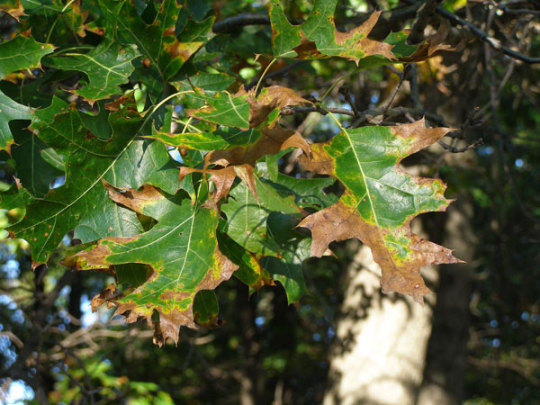
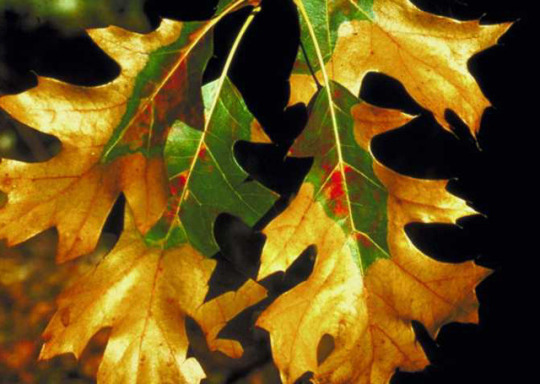
OAK WILT
Oak Wilt Scenarios:
This past July, Integrity Tree Services received a phone call from a customer requesting one of our arborists to have a look at their red oak tree. She informed us the mature red oak had been pruned in late May, and suddenly it was rapidly dropping leaves. This is a sign of oak wilt.
A customer called last September wanting his black oak tree examined. A storm had come through his neighborhood and broke a massive limb off the tree. He was very knowledgeable on oak wilt and knew the situation was precarious. We were able to save the tree.
Oak wilt (Ceratocystis fagacearum) is an infectious fungal disease, which causes rapid death in oak trees and in certain oak families, in a matter of weeks. Oak wilt can be transmitted by sap beetles (Nitidulidae) as well as oaks sharing roots underground, commonly called root grafts (Brown-Rytlewski, 2007). Oak wilt may occur when an oak is pruned in the spring or summer months.
During the warm months of the year, sap beetles are actively feeding on tree sap. The beetles find their meals by their strong sense of smell and are lured in, particularly to the smell of sap from a freshly cut oak (Johnson & Lyon, 1987). If an oak is pruned during the spring or summer months of the year, it is an open invitation for beetles potentially carrying fungal spores. Once a beetle finds a fresh wound, it can contaminate a healthy oak with the oak wilt fungus. The results are the vascular system clogging up causing leaves to turn tan, brown or bronze, and to fall rapidly from the tree.
The sap beetles lay their eggs in dead oaks and can often emerge contaminated with fungal spores (Johnson & Lyon 1987). The spore mat of the oak wilt fungus is commonly called a pressure pad. The pressure pad grows underneath the bark of an oak already infected with oak wilt from the previous year. This spore mat creates pressure on the bark and causes it to split. The beetles cannot resist the sweet smell of the fruiting body and will be drawn to it (Sinclair and others, 1987).
Not all methods of contracting the oak wilt disease are due to improper pruning. As described in scenario 2, branches break in strong winds or storms.
Not all oaks are extremely susceptible to oak wilt. Oaks in the red oak family (oaks with pointed lobes) are the most susceptible. Once infected with oak wilt, a mature, healthy red oak tree can die within the first month of contraction (Johnson & Lyon, 1987). Once a red oak contracts oak wilt, it is certain to die. Nothing can save a red oak tree after it is infected. Oaks in the white oak family (oaks with rounded lobes), however are much more resistant to the disease. The disease in white oaks is very slow to progress and white oaks can live with oak wilt for years (Johnson & Lyon, 1987).
It is very common to hear of heart breaking stories where a homeowner will try to save money by hiring a less-expensive, non-reputable tree company to prune their landscape trees. If an oak tree is to become infected due to improper pruning, all other oak trees on the property, as well as all oaks in the neighborhood, are at risk for contracting oak wilt.
We are approaching the autumn months, which is a good time to receive an estimate on getting your oaks pruned. After receiving an estimate, we will then schedule the tree work to occur in late fall or winter. If it is getting too late in the winter season and spring is near, we will wait until the following fall or winter before any tree work on oaks is done. We will not risk trimming your oaks too close to springtime.
Please email [email protected] if you’re interested in receiving more information on oak wilt.
0 notes
Text
Detoxication of DDT-14C in field populations of Meligethes aeneus Fabr. (Coleoptera: Nitidulidae)
http://dlvr.it/Nf2yMx
0 notes
Photo

50 notes
·
View notes